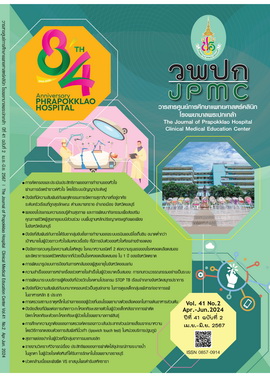Assessing the Efficacy of Artificial Intelligence in Left Ventricular Function Screening Using Parasternal Long Axis View Cardiac Ultrasound Video Clips
Main Article Content
Abstract
BACKGROUND: Echocardiography serves as a fundamental diagnostic procedure for managing heart failure patients. Data from Thailand's Ministry of Public Health reveals that there is a substantial patient population, with over 100,000 admissions annually due to this condition. Nevertheless, the widespread implementation of echocardiography in this patient group remains challenging, primarily due to limitations in specialist resources, particularly in rural community hospitals. Although modern community hospitals are equipped with ultrasound machines capable of basic cardiac assessment (e.g., parasternal long axis view), the demand for expert cardiologists remains a formidable obstacle to achieving comprehensive diagnostic capabilities. Leveraging the capabilities of Artificial Intelligence (AI) technology, proficient in the accurate prediction and processing of diverse healthcare data types, offers a promising alternative for addressing this prevailing issue. This study is designed to assess the effectiveness of AI in evaluating cardiac performance from parasternal long axis view ultrasound video clips obtained via a smartphone application.
OBJECTIVES: To evaluate the effectiveness of AI in screening cardiac function from parasternal long axis view cardiac ultrasound video clips obtained through a smartphone application.
METHODS: The authors developed a smartphone application that could be used to collect parasternal long axis view video clips and use artificial intelligence “Easy EF” to evaluate cardiac function. Out of 923 samples that were evaluated for LVEF by certified cardiologists, 739 clips were used to train AI, while the remaining 184 clips were used to test whether AI could process the results correctly. Artificial intelligence aims to classify cardiac function into three groups: Reduced EF, Mildly Reduced EF, and Preserved LV.
RESULTS: Out of 184 test video clips, AI achieved 96% classification results. The proposed AI was able to classify Reduced EF with 97% accuracy (36 from 37 clips), Mildly Reduced EF with 71% accuracy (12 from 17 clips), and Preserved LV with 97% accuracy (129 from 131 clips) P=0.0147. Overall accuracy was 96.2% (177 from 184 clips).
CONCLUSIONS: Artificial Intelligence in the form of “Easy EF” has been demonstrated to be promising screening tool for the assessment of cardiac function from parasternal long axis video clips. However, further development is needed, particularly to enhance accuracy in the Mildly Reduced EF group.
ClinicalTrials.gov Identifier, NCT06330103
Article Details

This work is licensed under a Creative Commons Attribution-NonCommercial-NoDerivatives 4.0 International License.
References
Krittayaphong R, Karaketklang K, Yindeengam A, Janwanishstaporn S. Heart failure mortality compared between elderly and non-elderly Thai patients. J Geriatr Cardiol 2018;15:718-24.
Bozkurt B, Coats AJS, Tsutsui H, Abdelhamid CM, Adamopoulos S, Albert N, et al. Universal definition and classification of heart failure: a report of the Heart Failure Society of America, Heart Failure Association of the European Society of Cardiology, Japanese Heart Failure Society and Writing Committee of the Universal definition of heart failure. Eur J Heart Fail 2021;23:352-80.
Komajda M, Schöpe J, Wagenpfeil S, Tavazzi L, Böhm M, Ponikowski P, et al. Physicians' guideline adherence is associated with long-term heart failure mortality in outpatients with heart failure with reduced ejection fraction: the QUALIFY international registry. Eur J Heart Fail 2019;21:921-9.
Laothavorn P, Hengrussamee K, Kanjanavanit R, Moleerergpoom W, Laorakpongse D, Pachirat O, et al. Thai acute decompensated heart failure registry (Thai ADHERE). CVD Prevention and Control 2010;5:89-95.
Nadruz W Jr, West E, Santos M, Skali H, Groarke JD, Forman DE, et al. Heart failure and midrange ejection fraction: implications of recovered ejection fraction for exercise tolerance and outcomes. Circ Heart Fail [Internet]. 2016 [cited 2023 Sep 15];9(4):e002826. Available from: https://www.ncbi.nlm.nih.gov/pmc/articles/PMC4807736/pdf/nihms763920.pdf
The Heart Association of Thailand under the Royal Patronage of H.M. the King. Heart Failure council of Thailand (HFCT) 2019 heart failure guideline. Bangkok: The Heart Association of Thailand under the Royal Patronage of H.M. the King; 2019
Xu X, Jiang Y, Chen W, Huang Y, Zhang Y, Sun X. DAMO-YOLO: a report on real-time object detection design. arXiv [Internet]. 2023 [cited 2023 Sep 15];2211.15444. Available from: https://arxiv.org/pdf/2211.15444
Rublee E, Rabaud V, Konolige K, Bradski G. ORB: an efficient alternative to SIFT or SURF. Proceedings of 2011 International Conference on Computer Vision; 2011 Nov 6-13; Barcelona, Spain. New York: Institute of Electrical and Electronics Engineers; 2011. p. 2564-71.
He K, Zhang X, Ren S, Sun J. Deep residual learning for image recognition. Proceedings of 2016 IEEE Conference on Computer Vision and Pattern Recognition (CVPR); 2016 Jun 27-30; Las Vegas, United States. New York: Institute of Electrical and Electronics Engineers; 2016. p. 770-8.
Feichtenhofer C, Fan H, Malik J, He K. Slowfast networks for video recognition. Proceedings of2019 IEEE/CVF International Conference on Computer Vision (ICCV); 2019 Oct-Nov 27-2; Seoul, South Korea. New York: Institute of Electrical and Electronics Engineers; 2019. p. 6201-10.

